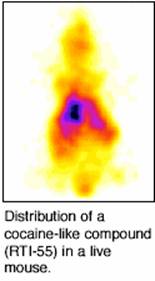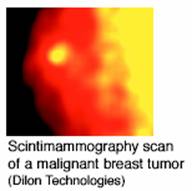Biomedical Instrumentation and Imaging at TJNAF
The TJNAF Detector Group has ongoing biomedical partnerships with ten academic institutions for instrumentation development and testing, a long-term CRADA with Dilon Technologies for commercialization of scintimammography, and an on-going negotiation with a Washington, DC-based biomedical firm for commercialization of small animal imaging.

TJNAF positron emission mammography (PEM) system used to image metabolically active breast tumors at Duke University Medical Center, shown integrated with an X-ray mammography system

Distribution of a cocaine-like compound in a live mouse

Scintimammography scan of a malignent breast tumor (Dilion Technologies)




